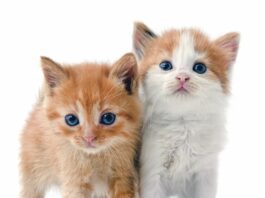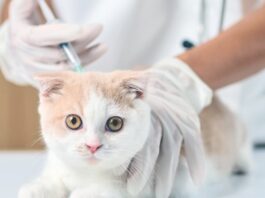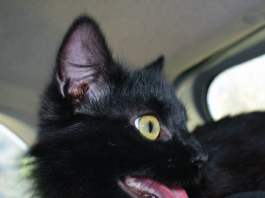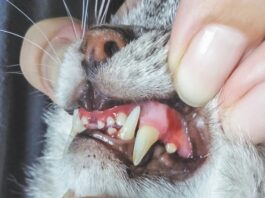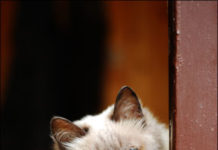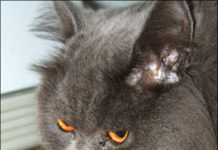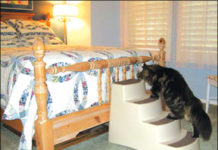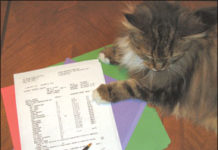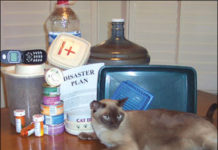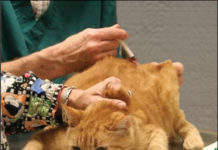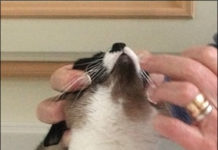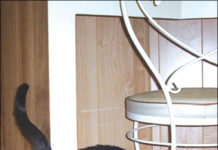Recognize Senility in Your Aging Cat
Thanks to advances in veterinary medicine, its not uncommon for a cat to live to the ripe old age of 20 - roughly the physiologic equivalent of age 93 in a human. Thats the good news. The bad news is that cats, like humans, become increasingly susceptible to age-related disease conditions as they grow old, and most of these disorders are bound to have an effect on an animals behavior. For example, arthritis is likely to cause an active cat to slow down dramatically as it transitions through its golden years; kidney and urinary tract disease may affect its litter box behavior; progressive periodontal disease and tooth loss may alter its eating habits; and progressive hearing problems may make a cat decreasingly responsive to its environment. In some cases, however, an elderly cats behavioral peculiarities will remain unattributable to any underlying disease condition. In such a case, the animal is apt to be diagnosed as "senile," a vague term used to describe an animal that exhibits physiologically inexplicable cognitive dysfunction, the outward signs of which resemble those associated with age-related dementia and Alzheimers disease in humans.
Charges in Melamine Pet Food Recall
ChemNutra Inc., a Las Vegas-based ingredients broker, pleaded guilty on June 16 to federal charges of distributing tainted wheat gluten that led to the mass pet food recalls of 2007. The charges stem from a February 2008 indictment that alleged ChemNutra imported more than 800 metric tons of melamine-contaminated wheat gluten from China between November 2006, and February 2007, then sold the product to various pet food manufacturers.
Vomiting: When to Take it Seriously
You hear a familiar retching sound in the kitchen. Striker is vomiting up his dinner again. As you walk downstairs to clean up the mess, you wonder if its just hair balls - or something more serious that requires a trip to the veterinarians office. Cats vomit for numerous reasons, ranging from benign dietary indiscretion to potentially fatal systemic diseases such as renal failure or hyperthyroidism. The experts say that cat owners should pay close attention to a cat that regularly becomes sick to his or her stomach. Be Observant. "When it comes to vomiting, the important concept for cat owners is observation," advises Fred Scott, DVM, PhD, interim director of Cornells Feline Health Center. "Vomiting in association with signs of systemic illness must be addressed rapidly." Signs include lethargy, fever, loss of appetite or weight loss. Even if the cause of vomiting is transient or self-limiting, loss of fluids and electrolytes can have life-threatening consequences.
Diagnosis: Bladder Stones
Your cat normally uses the litter box a few times a day to relieve herself, but today is different. Shes going to the box every few minutes and vocalizing as she strains to urinate. The small amount of urine that finally dribbles out is filled with blood. Your cat may be suffering from bladder stones, a painful condition that, left untreated, can lead to serious illness and in rare cases, death. Causes of Bladder Stones. Bladder stones, or uroliths, are caused by an extensive concentration of salts and minerals in the urine such as magnesium, phosphorous, calcium, and ammonia. "There should always be a certain amount of salts and minerals in the urine," says Richard Goldstein, DVM, an associate professor of small animal medicine at Cornell Universitys College of Veterinary Medicine. "But when the urine becomes super saturated - meaning theres an overabundance of salts and minerals - crystals begin to form."
Protect Your Plants and Keep Kitty Happy: Grow Grass Indoors
Everyone knows that cats are carnivores. So why does your cat keep snacking on the houseplants? Some experts say greens help cats get rid of hairballs, others that cats crave the fiber and moisture. There may be a nutritional component as well: when feeding on prey, a cat will eat the intestines first, where its likely to find plant matter. But regardless of the reason for the craving, plants can prove a serious danger to cats. Many common houseplants, such as lilies, asparagus ferns, and foxglove, are poisonous. Outdoors, a cat may eat grass or other plants contaminated by pesticides and fertilizer.
Ask Elizabeth: 06/09
The dark brown color of normal cat stool largely results from substances in the bile, a liquid produced in the liver that then empties into the first part of the small intestine. Bile aids in the digestion of fats and contains a number of substances, among which are breakdown products of aged red blood cells. These breakdown products impart the yellow color that is characteristic of bile. As these yellow pigments pass in stool on the way out of the body, bacteria residing in the large intestine break them down further, so their original yellow color is changed to a dark brown.
Is Your Cat Slowing Down?
At the age of 12, your cat seems to be slowing down a bit, and that could be perfectly normal. After all, a cat of her age - equivalent to the age of 65 or so in a human - has been living a full life and deserves to take it easy on herself. Nevertheless, its a good idea to have the animal checked out by your veterinarian. Its quite possible that her diminished activity is a consequence not of her advancing age but of a debilitating pain in one or more of her joints. Slowed-down, reclusive behavior is an indication of a joint problem in cats of any age, says Christine Bellezza, DVM, a consultant at the Cornell University's College of Veterinary Medicines Feline Health Center. "Some of the signs are very subtle," she points out. "An affected cat may seem lethargic and may increasingly seek out comforting places to nap - in a warm corner of your home, for example, or in a spot of sunshine near a window." The reclusive behavior can also be attributed to a deeply ingrained feline instinct for self-protection. A cat may want to conceal its disability for fear of alerting a potential predator to its vulnerability. Other indications that a cat is suffering pain in one or more of its joints may not be so subtle. "The cat may have trouble hopping in and out of its litter box," says Dr. Bellezza, "and it may avoid going up and down stairs." It is also possible for a cat with a severe joint problem to become constipated because it cant position itself properly to defecate. Furthermore, due to joint pain, an affected cat may be unable to groom itself thoroughly.
Feline Pancreatitis: Serious
Although the feline pancreas is a relatively small internal organ, typically weighing no more than six or eight ounces, it plays a demanding and multifaceted role in maintaining a cats robust health. Indeed, a disease or injury that results in the inflammation of this vital organ - a condition called pancreatitis - could prove fatal unless the animal receives prompt, and potentially quite expensive, medical care. The pancreas is a slender, pink, v-shaped strip of tissue resting snugly within the cats abdomen between its left kidney and its duodenum. It is a glandular organ that performs two life-sustaining functions-endocrine and exocrine. While still in the pancreas, explains Richard Goldstein, DVM, an associate professor of small animal medicine at Cornell Universitys College of Veterinary Medicine, these digestive enzymes are normally sequestered in tiny droplets that prevent their coming into direct contact with pancreatic tissue. Moreover, he says, the enzymes are biologically programmed to remain inactive until after they have been secreted and have traveled via the pancreatic duct into the small intestine.
Pet Owner Fire Safety Tips
When an out-of-control firestorm raced through the hills above Santa Barbara, California, last fall, frantic residents had little time to grab a few belongings and flee. "My wife and I were able to safely evacuate with our dogs and one of our cats," remembers Jason Bryan, a resident of Montecito, a tiny enclave of Santa Barbara. "Unfortunately, our other cat, Sunny, is adept at hiding, and we couldnt find him before we had to leave. For days, the Bryans lived in a cramped motel room and were forced to wait and wonder whether their house - and beloved cat - had survived the flames. On the fourth day, they were allowed to return to their burned out neighborhood. "Miraculously, our house was still standing," says Marian, Jasons wife. "And best of all, we found Sunny inside, hungry and lonely, but alive. We feel truly blessed." Some were not as fortunate as the Bryans. Sabrina Robinson was just finishing up her workday at a medical supply company when the fire broke out shortly before 6:00 pm on that fateful day. She wasnt aware of the imminent danger until she stepped outside and smelled the acrid smell of smoke.
When to Vaccinate Your Cat
During the past half-century, no fewer than 10 vaccines have been developed that, according to their manufacturers, can protect your cat against a wide variety of lethal feline diseases. In general, these claims of efficacy have been justified. According to Fred Scott, DVM, PhD, professor emeritus of virology at Cornell Universitys College of Veterinary Medicine and the founding director of the Cornell Feline Health Center, the vaccines have been responsible for "a tremendous improvement in feline health." He cites as a prime example the vaccine created to protect against the feline panleukopenia virus (FPV). "Prior to the late 1960s and early 1970s," says Dr. Scott, "half of all cats that passed through a shelter developed panleukopenia within a few days - and as many as 90 percent of them died from it. Today, the FPV vaccine has totally controlled the disease in properly vaccinated cats. The only time you see it now is in unvaccinated feral or farm cats or those that are in shelters, but that is rare." However, he points out, there are several reasons why owners should refrain from having their cats inoculated annually with every available vaccine. For example, it is remotely possible for a vaccine to damage a developing fetus or stimulate an allergic reaction. And of growing concern is the development of vaccine-associated sarcoma - a type of cancer that, for unknown reasons, emerges at the site on a cats body where a vaccine has been injected. Furthermore, research has brought into question the need for all cats to be routinely revaccinated with all available vaccines every year throughout their lives. Certain laboratory tests may reveal that, as the result of a previous vaccination or natural exposure to an infectious agent, the antibody levels in a cats blood remain high enough to protect it against a specific virus or bacterium. In that case, the animal would be protected against disease associated with that infectious agent and a booster shot would be unnecessary.
Medicating Your Cat
For many pet owners, the realization that a cat will require medicating - even for just a few days - is enough to cause serious apprehension. Though some felines are extraordinarily good when it comes taking their medicine, others are not. Cats can be notoriously difficult to capture, restrain and medicate; however, with the following expert tips, medicating a cat can be much less stressful - for both cat and owner. "One of the biggest stumbling blocks for cat owners is the mindset with which they approach medicating their cats," explains Jodi Korich, DVM, the director of Partners in Animal Health at Cornell Universitys College of Veterinary Medicine. If you are nervous about medicating your cat or perhaps youre feeling incredibly worried because your kitty is ill, your cat will pick up on this. "You have to approach medicating your cat with the mindset that you are doing this for the cats own good, working calmly, quickly and not obsessing over the process," recommends Dr. Korich. A positive, confident approach may make your cat feel more secure.
Is it Urinary Incontinence or Urine Marking?
When a cat begins soiling the house, it is usually assumed that it is a behavioral problem or the onset of senility. However, there are several medical conditions that can cause urinary incontinence and inappropriate urination, some of which require immediate treatment. First, it is important to distinguish between incontinence and inappropriate urination. True incontinence occurs when a cat does not have voluntary control over urination; trauma, a weak primary sphincter muscle and congenital abnormalities are the most common causes of incontinence. Inappropriate urination is much more common than true incontinence; this may be a behavioral problem or it may be the result of an underlying medical condition. The most common medical cause of inappropriate urination is inflammation of the urinary bladder. While the root causes often vary significantly, the signs - called lower urinary tract signs or LUTS - are similar: frequent urination, excessive licking of the genital area and difficult or painful urination. The actual diagnosis can range from a urinary tract infection to urethral blockage. It is extremely important to seek veterinary care if your cat exhibits these signs - do not assume that the animal is simply constipated. If he is suffering from urethral blockage, he may lose consciousness and die within a day or two of complete blockage. On the other hand, it may turn out to be something as treatable as a urinary tract infection. To begin with, your veterinarian may ask several questions...


